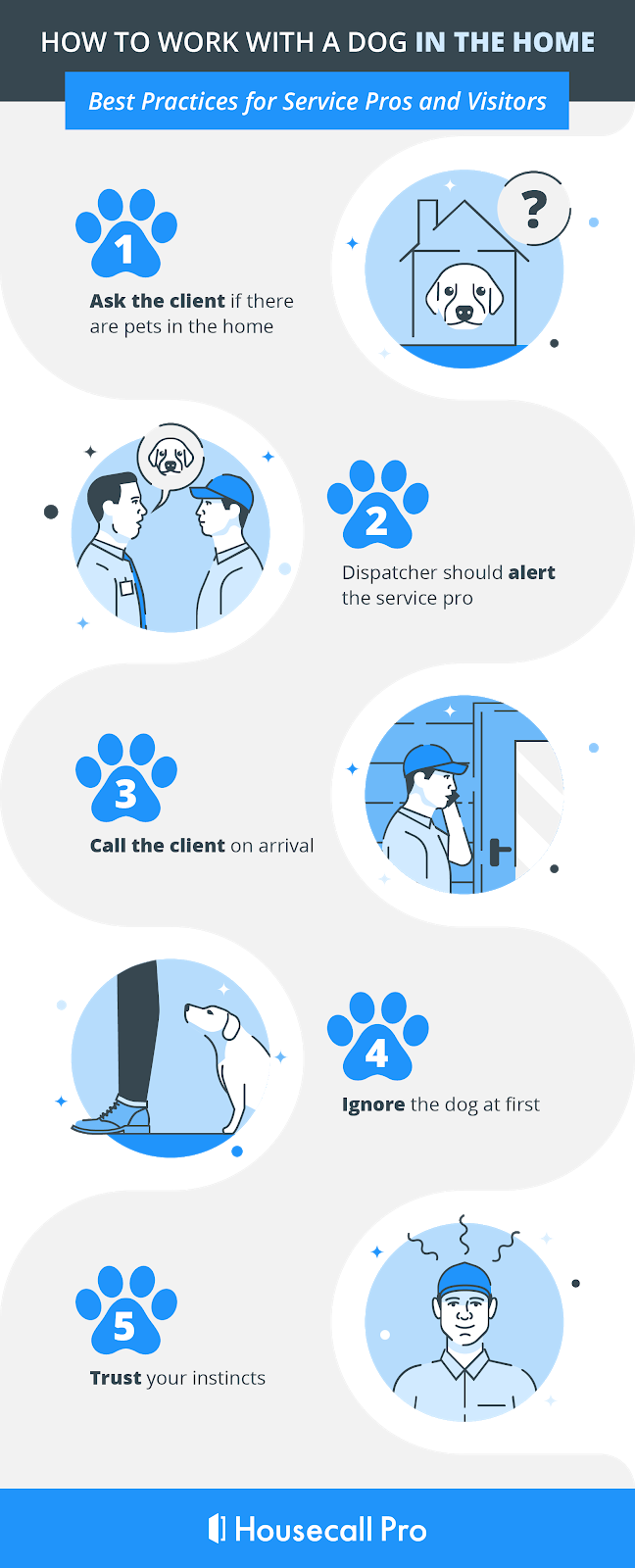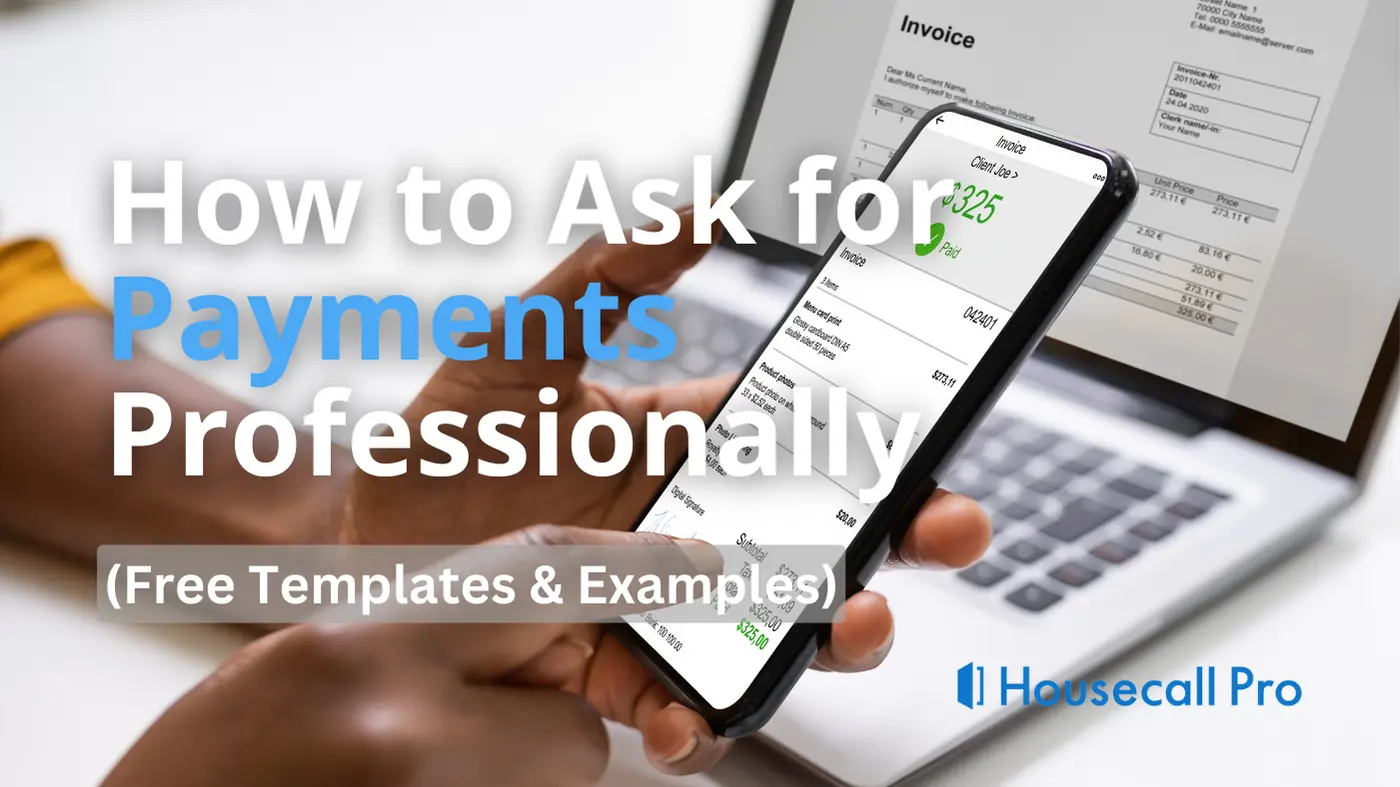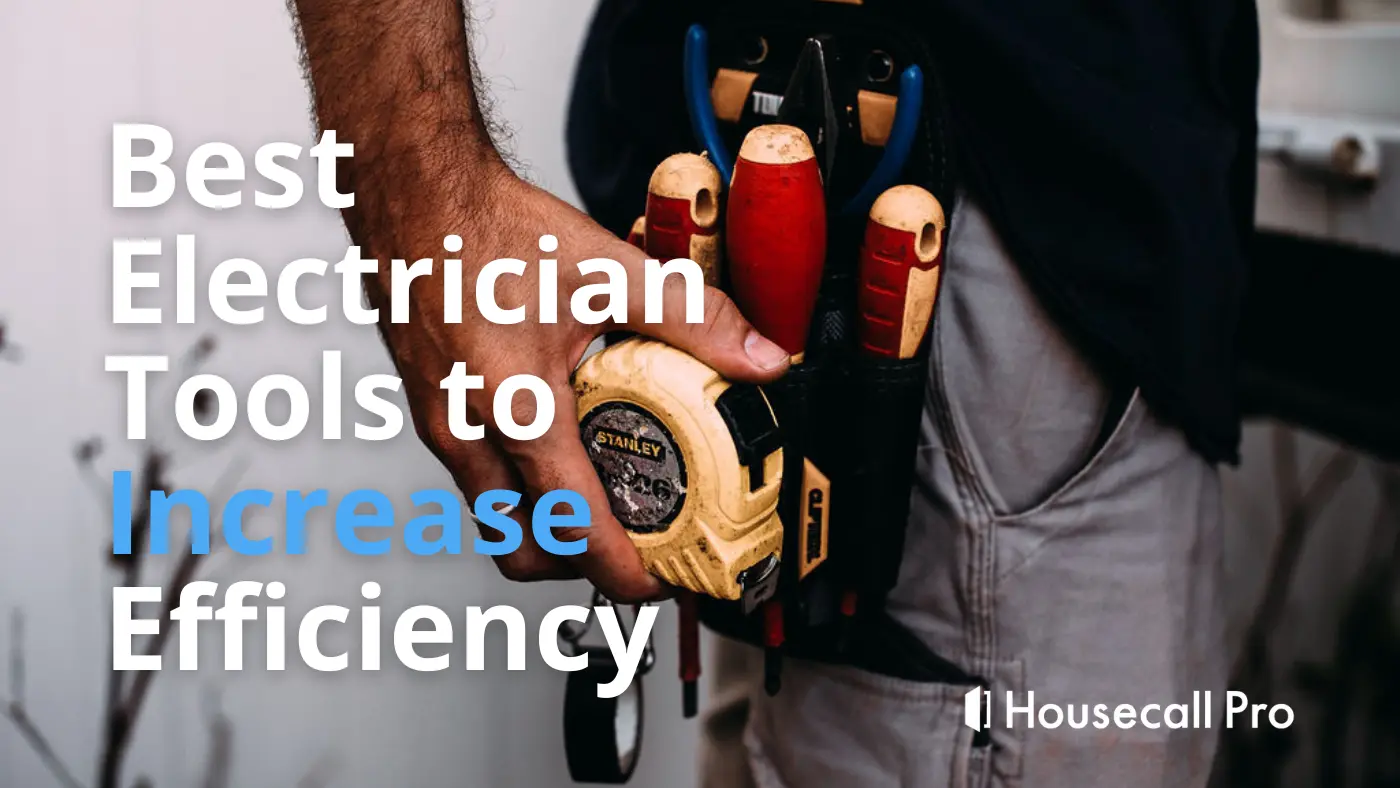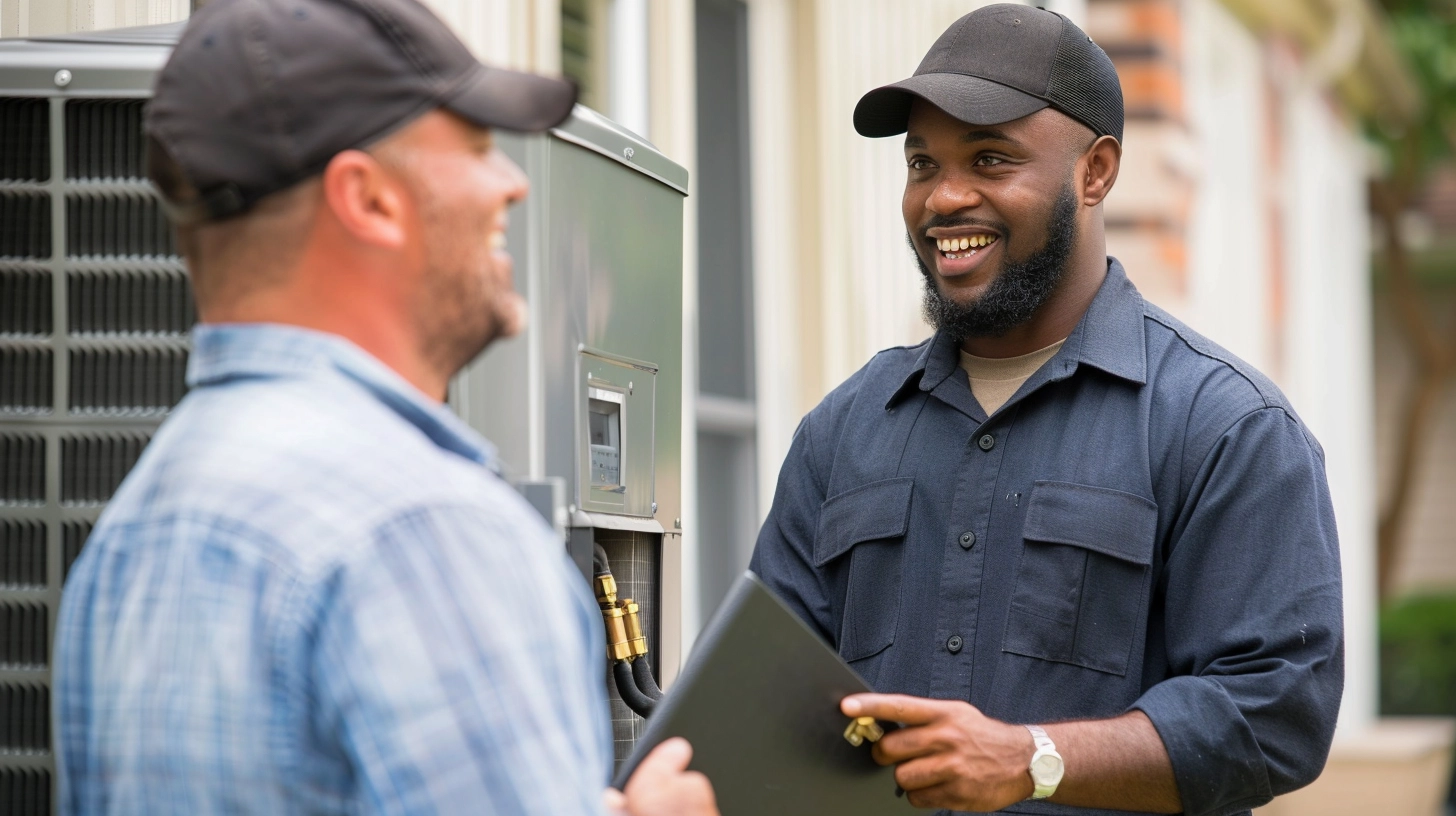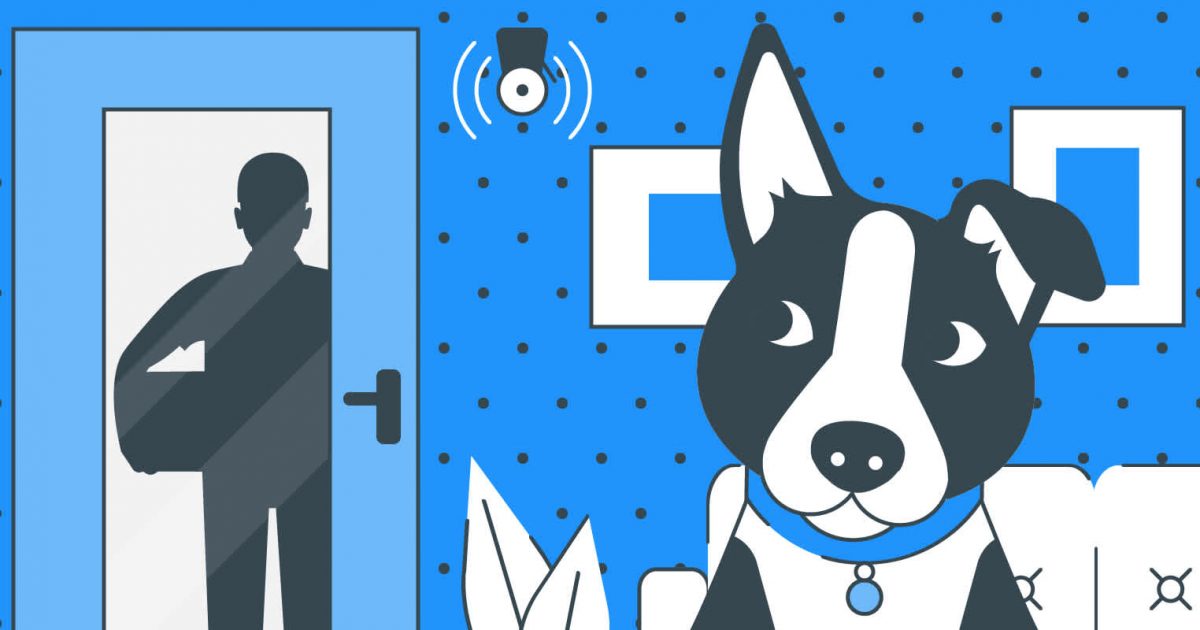
Every year in the U.S. there are more than 4.7 million dog bites, 17% of which result in the need for medical attention. It’s safe to say that the majority of these bites happen to people the dog is unfamiliar with.
But why do dogs bite?
Dogs bite for all kinds of reasons. The American Veterinary Medical Association reports that any dog can bite if they are scared or have been startled, protecting or defending, or even just playing. Socialization helps prevent biting behavior but educating yourself, children and employees on how they should approach a dog is very important.
For example, visitors to the home are more susceptible to scare or startle a dog as they are entering the dog’s space unbeknownst to the dog. This not only includes friends and family visiting, but also those hired to work in the home. Plumbers, general contractors, electricians, HVAC technicians, maids or cleaning professions are at risk as well.
To prepare you and your dog for new visitors in the home, we have compiled a list of best practices and important dos and don’ts for the homeowner and service professional to follow to allow for a positive and productive visit.
Best practices for the homeowner
Having visitors or strangers in your home can be daunting and it is even more so for a dog. Here are a few best practices to follow when having a service professional visiting and working on your home with your dog nearby.
1. Notify the service provider that you have a dog
When you schedule the appointment with the service provider, let them know there is an animal in the home. Provide your dog’s name, breed, and any personality (ie. tends to be anxious or likes to bark) or logistical details (ie. will be in a kennel in the bedroom) that will allow the service professional to interact or not interact with him or her in a positive way.
2. Exercise 30 minutes before
If possible, exercise your pet 30 minutes before the service professional arrives. This could mean going on a walk, run or playing with their favorite toy. This gives your furry family member a chance to burn off some excess energy which will allow them to feel more relaxed when the guest arrives.
3. Kennel or place your dog in another room
It is important to keep your pet away from the service professional or technician as they are working. Place your dog in a kennel or in another room with the door closed. This will allow the service pro to work unhindered to diagnose and fix the issue at hand while keeping your dog safe from any sharp objects or open doors where they could accidentally escape. This is even more important if you will not be home during the visit.
Please note that some service professionals may require your dog to be in a kennel, another room or outside while they work. Others may even refuse service when they know there is an animal in the home. While this may be an inconvenience, be understanding as they are just concerned for their safety and the safety of their employees.
4. Introduce your dog slowly but not while work is being done
If your dog feels more comfortable after socializing or if the service professional will be working in the home for an extended period of time, it makes sense to slowly introduce your dog to the service pro. When work is not being done and there is no time constraint, slowly introduce your dog by leading him or her on a leash to the service pro. Have the service pro not stand directly in front of the dog, this can be intimidating, and allow your dog to make the first move.
5. Encourage positive interactions
If your dog interacts with the visitor or service pro in a positive way (no signs of aggressive behavior), reward your dog with treats or verbal affirmations (good boy or girl!). Give the service pro a few treats so they can reward him or her as well! This is important to reinforce positive behavior and ensure more positive interactions in the future. However, do not get upset if your dog seems fearful. Give them space and try again later.
Best practices for the service pro
Visiting a home for the first time can have some risks but there is no need to be worried about a pet in the home when a few parameters are followed. Here are the best practices for working in a home with dogs.
1. Ask the client upfront if there are any pets in the home
Just because the homeowner should alert the service provider that there is a dog in the home, doesn’t mean they always will. Take initiative and as the client upfront if there are any pets in the home. Ask about the dog (name, breed, personality, etc), this is not only a great way to learn more information to relay to the service pro taking the job but to get to know the client on a personal level.
2. The dispatcher should let the service tech or pro know so he or she can prepare
If you manage a team and know that a job will have a dog in the home, alert the tech or service pro assigned to the job. This is important in case the tech is allergic or afraid of animals and you need to assign someone else. If not, the service pro will in the least not be surprised and may be able to provide a better customer experience because of it.
In addition, Housecall Pro’s real-time dispatching software can make this process seamless through easy scheduling and by automatically notifying team members and customers of any changes.
3. Call the client when you arrive
Call the client rather than knocking on the door or ringing the doorbell. Many dogs get excited when they hear someone is at the door, and calling ahead to alert the owner can create a calm environment before you enter the home. It goes the distance with the client and can make the job go along smoother.
4. Ignore the dog at first
If the dog is not in a kennel or away in a room or if the client just wants to introduce you, ignore the dog at first. Don’t make eye contact right away. This could mean talking to the client for a few more minutes or looking at your phone. This gives the dog a bit of space to adjust and not feel the need to have an immediate reaction.
If the homeowner is not at home, follow this tip exactly. If you had expected the dog to be in a kennel or locked in a room or did not expect a dog at all, talk to dispatch or your manager, let them know of the situation. If you feel uncomfortable or unsafe, leave. It is not worth risking your safety for.
5. Trust your instincts
Lastly, like mentioned above, trust your instincts. If the dog is making you uncomfortable, respectfully explain to the client that you would feel more comfortable if the dog was on the leash or away from your work area. It is far better to air on the side of caution than risk your safety or put the dog in a difficult situation that could lead to an unfortunate outcome.
Expert tips from the Housecall Pros
Below are tips from real superpros within our community.
Sign up to learn more and collaborate with like-minded industry pros.
- Health is priority number one. For example, say you are hired to work on service and install in a basement, but when you arrive, you find 15 over used litter boxes with cat feces and urine all over the floor. What do you do? Politely explain that the environment is unsafe for your workers and the area will need to be cleaned or you will need to refuse the job. It is within your right to do so.
- Wear protective covers or booties over your boots! Animals can create messes in the home but that does not mean every home with a pet will be like the home described above. If the home is a bit messy and you do not feel comfortable taking off your boots, wear protective covers on your boots to protect the home and keep the client satisfied.
- Bring custom, branded treats to jobs or send gifts to client’s dogs. A little gesture can go a long way. Bring treats (with your company name on them) to give to the dogs or owners when you arrive, just make sure they are allergy free or hypoallergenic. Another way to standout is to record the names of your client’s dogs and send them doggie themed gift baskets! Include toys and a note thanking them for choosing you.
- Liabilities are valid reasons to insist a policy is enforced! Never be afraid to quote liability as a reason for anything. If you are concerned with working with a pet or dog in the home, request the dog be put away in a kennel or locked away in a room or outside. You can also decide to refuse any jobs with a dog or large pet in the home. Safety should come first for you and your workers.
Dos and don’ts of meeting a dog for the first time
When you meet a dog for the first time, it can be intimidating. The owner is so excited to share their beloved fur-baby, you may be new to the home, and the dog could be overly excited or even fearful. These dos and don’ts of meeting a dog for the first time.
Do: Let the dog approach you
Let the dog approach you on his or her own. Don’t force it by running towards them with open arms. This is important to not come across as intimidating and startle them in the process. Ultimately be natural, careful and confident when meeting a dog for the first time.
Do: Let the dog sniff you
Letting the dog sniff you will play into the dog’s natural instincts. Dogs smell people, objects and other animals to get a feel for who and what they are. Let the dog approach, sniff and decide about you on their own terms.
Do: Pay attention to the dog’s body language
Pay attention to the little things the dog does with their body, otherwise known as their body language. Do they have their head raised high, is their tail wagging, are they drooling or panting rapidly? These are signs of different emotions and can tell you how the dog is feeling about you being in their space. We expand on this later in the post.
Don’t: Use “baby talk”
When you meet a dog for the first time, try to use a calm low voice. Higher pitched voices common with baby talk can signal weakness and actually stress out a dog. Start the relationship strong and confident with your natural voice and tone.
Don’t: Pet the dog right away
It is important that when you first meet a dog, to respect their boundaries. This includes not petting them on the head right away. This can be threatening for a dog and even more so if the person is a stranger. If after a few minutes of meeting the dog seem comfortable, you can try petting them on the back or shoulders but proceed with caution.
Examples of canine body language
When meeting a dog for the first time, it is very important to look for certain behaviors and react to the signs appropriately. Here are a few common emotional responses and their corresponding body language.
Fearful or Threatened
- Round glassy eyes with dilated pupils
- Closed mouth
- Rapid panting
- Drooling
- Low tail position
Aggressive
- Wrinkled muzzle
- Hard eyes
- Tense, firm body position
- Head raised above shoulders
- Leaning forward
- Potentially growling
Relaxed or Submissive
- Backward facing or side facing ears
- Lowered head
- Soft body posture
- Neutral tail position
Excited
- Raised tail with slow or rapid side to side movements
- Hair is raised
- Forward ear position
- Loose and wiggly body movement
In summary, education and preparation are key to allow for a positive and productive visit from a service professional or other visitor. When meeting a dog or visiting a home with one, keep in mind these best practices and dos and don’ts. Remember to trust your instincts and stay alert to ensure a happy home and happy pet!
We are always talking shop and covering lessons we’ve learned from working in the trades on our blog. Learn how Housecall Pro can help make every housecall more effective, efficient, and beneficial for your field service business.
